There are several reasons why a high E-string can break. However, the most common reasons usually involve over-tensioning due to increased moisture absorption in the guitar’s body, aggressive playing techniques, or flaws in the guitar itself like sharp fret edges.
In other words, when the wood of your guitar body expands due to a change in moisture, the strings go a bit sharp, sometimes almost by a full semi-tone. Once you apply even more pressure on the string to which it’s not usually accustomed, it ends up snapping.
For that reason, it’s best to always make sure your instrument is tuned properly before you start playing. This is the primary reason why your high E-string continues to break. With that said, there can be other explanations, which we’ll explore more in detail.
Truthfully, the explanation I just provided is something I noticed about my own particular situation. You may find your strings snap for a totally different reason, and we’ll explore some of them below.
8 Reasons Why Your Guitar Strings Keep Breaking
1) Changes in moisture/humidity and temperature.
2) A burred fret
3) A burred saddle
4) Strings that are too light
5) Not stretching your strings before playing
6) Improperly wound strings
7) Bad batch of strings
8) An issue with the nut
Now let’s explore each one, as well as the solution.
1) Expansion and contraction of the guitar’s wooden body due to changes in moisture/humidity and temperature.

Solutions:
There are a number of solutions to this, including keeping your guitar in a room where the humidity and temperature are controlled, or even just using a special case for the instrument.
Another thing that you can do, which I already mentioned above, is simply tuning the guitar before you start playing it again. I would recommend one of the Snark head-stock tuners like this one.
The great thing about Snark tuners is they’re inexpensive and can be purchased either on Amazon, or any local music store. While they’re not the best tuner on the market, they’re convenient, inexpensive, and easy to use.
2) A burred fret
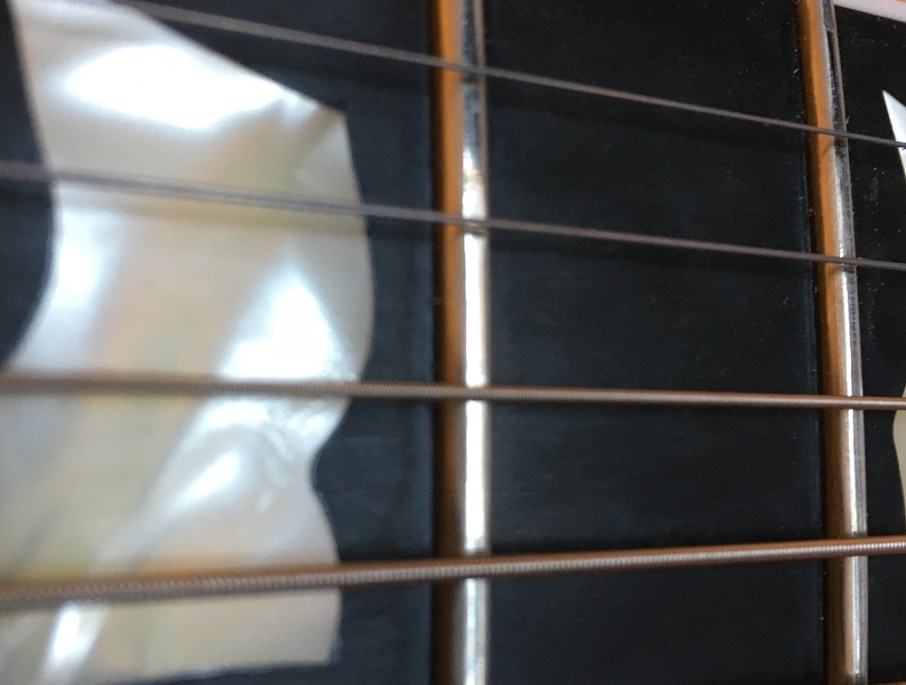
A “burr,” is when there are little sharp edges on a piece of steel or metal.
A “burred” fret can happen as a consequence of a number of things.
It could be an issue with how the instrument was originally manufactured, or it could be due to wear and tear over time. It’s hard to say for sure unless a luthier takes a solid look at it.
Some people even argue that a player’s bending technique can slowly burr the frets over time.
Solution:
I would recommend taking your instrument to a luthier and having him take a look at the fret. You don’t want to risk ruining a fret on your guitar and having to replace it.
If you want to do it yourself, you would just have to purchase superfine wool or a local department store, put tape on the fretboard, and then sand the frets down ever-so-gently. Super-fine wool is crucial; don’t use anything more coarse than that.
3) Burred Saddle
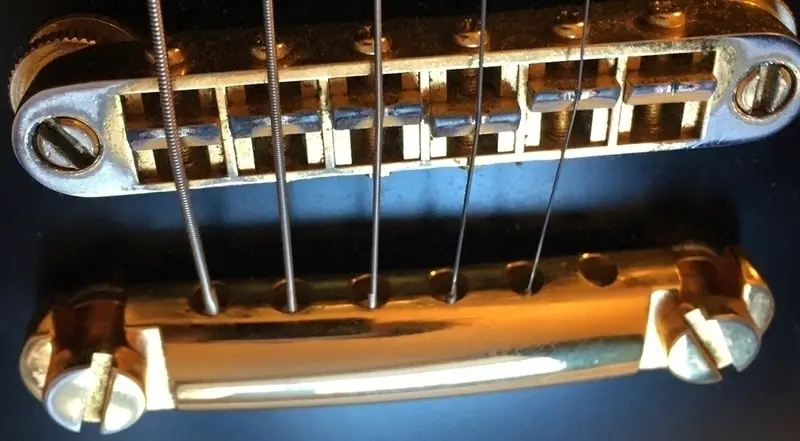
The saddle is on the opposite end of the guitar to the headstock where the strings sit. Sharp edges and burrs where the strings sit can slowly eat away at it until it finally breaks. This is less common but it could also happen.
Solution:
Again, you could go at it with some super-fine wool, or take it to a luthier. I would recommend the latter.
4) Too Light of Strings
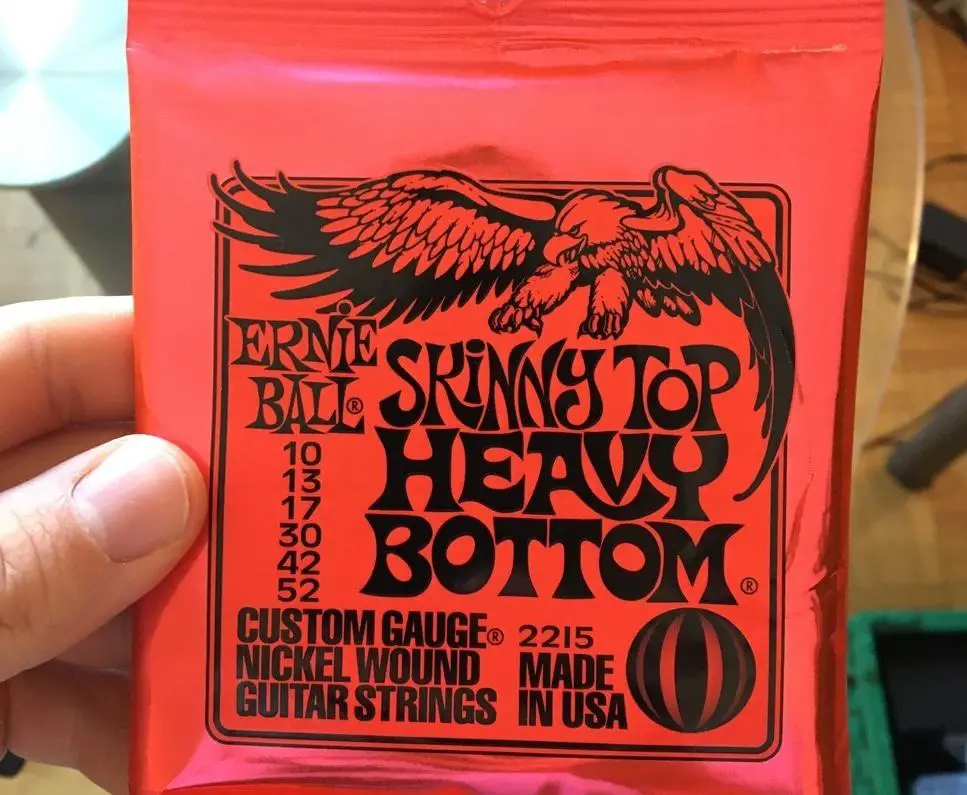
String gauges can make a huge difference as well. The higher the gauge, the thicker the string. The thicker the string, the less prone it is to actually snap while playing.
Typically, I use the skinny top, and heavy bottom strings made by Ernie Ball, Or, the 11 to 52-gauge strings are a good choice as well. I just find these strings to be a lot meatier and easier for me to play, considering I’m quite heavy-handed.
Anything less than that, and I feel like the strings are just unbearably bendy, almost like trying to play a jellyfish. It’s up to you to determine what works best for you.
Truthfully, there are a lot of benefits to playing the guitar with more of a gentle hand. Pressing too hard on the strings can cause intonation issues, and create all kinds of problems, including snapping the strings, pain, fatigue, and other negative feelings in your hands.
Experimenting with thicker string gauges can open you up to a different world, so to speak, in terms of the variability of playing style and tone.
Solution: Get thicker strings!
The type of strings you use may have a lot to do with the style of music you play. For instance, in metal, it’s not uncommon these days for songs to be tuned all the way down to drop B or Standard D tuning – which is down a whole tone.
Due to the increased tension on the string, they actually need to be a bit thicker, that way they’re still pulled tight, despite being tuned much lower.
From what I understand, it’s also quite common for jazz guitarists to use thicker guitar strings. I’ve certainly used them before. Stevie Ray Vaughn famously used very thick strings, some say 13-58, which are quite thick.
I would recommend a premium brand of thick strings, for instance, Elixier’s 11-52 gauge strings. You can check the price out on Amazon. What makes these special is they’re also coated in an anti-rust material that makes them last longer.
5) Not Stretching Your String After Setting Them Up
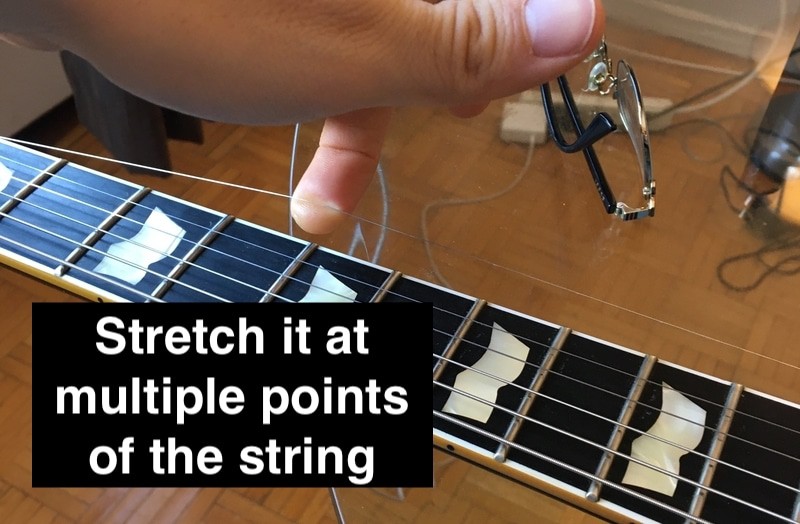
Most guitar players actually stretch their strings a little bit either before they’ve strung them up or after. What I typically do, is after I string the guitar, I purposefully pull on the string with my finger underneath it toward the ceiling.
It’s important not to stretch so hard that you snap the thing, but just pull on it a little bit at different points of the string, that way it stretches out, and when you make a bend, the string has already stretched a bit and is accustomed to more tension.
You don’t want to just throw a pack of strings on your guitar without getting them used to tension. There are alternative ways of stretching your strings, but simply pulling them up toward the ceiling is the best way of going about this.
6) Improperly Wound Strings
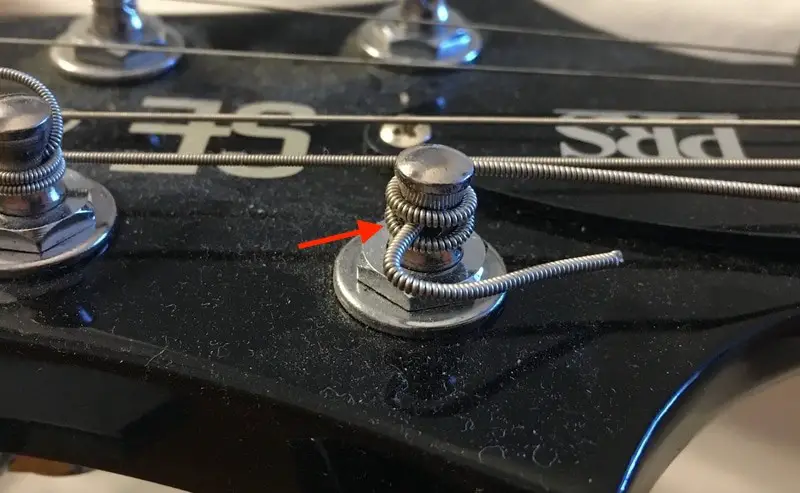
This is another very common reason for string breakage, and certainly, one that I’m guilty of, considering I’m still not the best at stringing up strings on a guitar, despite playing my entire life.
When the string is wrapped around the tuning post, it can be done improperly in such a way that is conducive to unnecessary break-points and additional tension. You can see what this may look like in the image above. Once you add a little more tension, all of a sudden you’ve got a string snapping.
Sometimes, when the string is wound improperly, I’ll do a bend and I can actually hear the string starting to snap at the top of the guitar’s headstock. It’s a subtle sound but it’s not that hard to hear.
If you really hate stringing up a guitar, you could also look into purchasing some Sperzel locking tuners, which are great for convenience and also time. My ESP Eclipse-II takes seconds to string up. Sperzel locking tuners are great; you can check out a pair on this page.
Solution:
When you wrap the string around the post, you want to bend the string toward the right and then tuck it underneath itself, with the string pointed up toward the ceiling. At this point, you start tuning the string while using your thumb to press the string against the headstock.
Additionally, you want there to be 8-9 cm between the string and the fretboard when pulling up on it. Too much string can cause it to slip and go out of tune.
Continue tightening the string until it’s finely tuned, carefully taking notice of how the string wraps around the tuning post. In other words, the string should be wrapped around the post in a way that’s very clean, and on top of each other.
The strings shouldn’t be knotted together, with some looping up and others looping down.

Moreover, it’s important to note that the correct amount of string needs to be used as well. You don’t want excess string wrapping around the tuning post, because then you have a build-up of string.
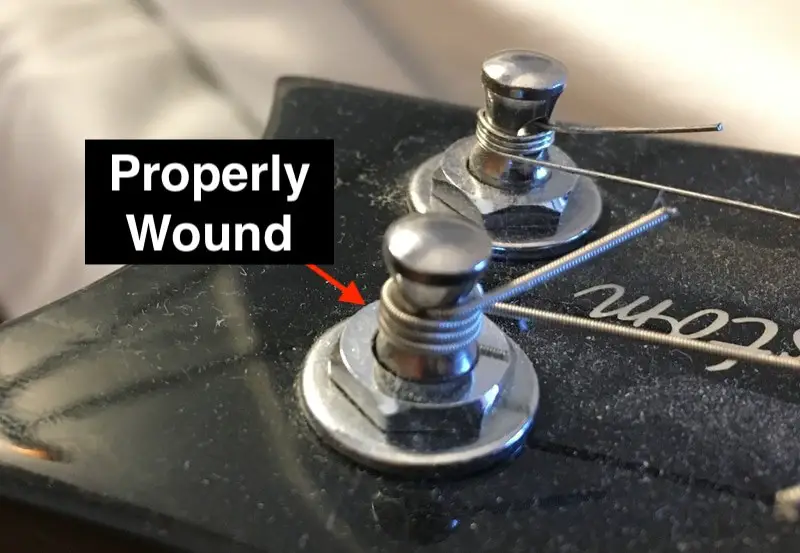
7) Bad Batch of Strings
It’s possible that you did get a bad batch of strings, so if you purchased several sets at once, maybe you got several sets of bad strings.
Truthfully, this isn’t that common, however, and string breakage probably has a lot more to do with the reasons I’ve mentioned above.
8) An Issue with the Nut
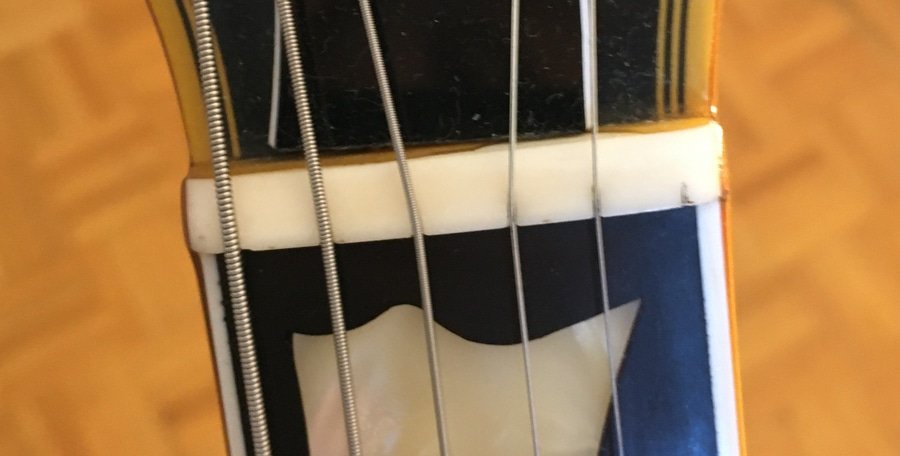
Another less common reason is due to something going wrong in the nut. As I pointed out in my guide to nuts, the nut is the area where the guitar strings sit in, but rather than being in the saddle on the body of the guitar, the nut is just on the headstock, right before the tuning posts.
Some guitar players reportedly use some kind of lubricant for the string in the nut. I don’t do this, and I’ve never done this, but some people claim to do it.
Other Important Tips For String Longevity
Thankfully, there are a ton of different things you can do to increase your string’s longevity and thwart it from breaking. You can wash your hands before you start playing, or always wipe the strings down after you’ve played the instrument.
Typically, I rarely wash my hands before I play the guitar, but it’s not uncommon for me to wipe them down after I’ve played with a microfibre cloth.
I’ve written a whole other article on how to go about increasing the life of your strings, so it’s worthy to check out. It’s at this link here.
Things To Look Out For
There are a number of things you can pay attention to when your strings are continuously snapping. But the primary thing you want to take a look at is at what point the string is actually snapping. Boiling your strings (my guide on this), can also weaken the integrity of the strings.
For instance, if the string snaps near the headstock, it might have something to do with how the strings are wound, or perhaps the issue is one of the frets near the headstock.
On the other hand, if the string is snapping right at the tail-piece of the instrument, there might be some rough edges in the tail-piece, either right in the hole, or on the saddle, itself.
Another point worth emphasizing is how you go about bending the strings when you’re playing. A sub-optimal bending technique will erode the frets with time.
In other words, if you play the guitar every single day and are continuously pressing down too hard on the fret while bending, you may wear down those frets.
If you’re the type of player who uses minimal pressure while bending, and you don’t press the string extremely hard against the fret, the surfaces of the fret will be smooth and likely won’t degrade over time.
On the other hand, if you’re continuously pressing super hard all of the time, the smooth fret could increasingly become roughed up over the years, and thus, leading to snap-happy strings.
The pressure while making a bend should almost be sideways, rather than down and toward the fret. Go ahead and try bending the guitar string without applying so much downward pressure toward the fret.
You may discover just how little pressure is needed to actually fret and bend the note.
***Another great way to combat a continuously breaking e-string is to head down to your local music store and buy 3-4 single e-strings, that way when you break it, you don’t have to swap out an entirely new set.


 Written By :
Written By :
